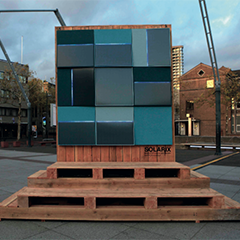It’s been three years since the founding of Kameleon Solar and I find myself, only now, writing the first in-depth article about our company. It’s not that we’ve never had news worth sharing, as you will find, there have been plenty of milestones. Your first publication largely defines who you are as a company, and I prefer to share what we have accomplished rather than what we plan to.
Kameleon Solar was founded mid 2015 with the aim of producing custom-made flexible, glass/backsheet and glass/glass modules for BIPV and PIPV (product integrated photovoltaics). Like most solar companies, we focused on price, efficiency, on warranties. Production-wise, we focused on quality, costs, and efficiency. It didn’t take long for us to find out why this standard solar manufacturing recipe simply doesn’t work when you’re dealing with architects, custom-made PV and BIPV façades, in general.
Our first issue was that we weren’t the only ones to step up to the increasing demand of custom-made PV. Based in a high-wage country like the Netherlands, it is difficult to compete with countries that can offer the same services at a lower cost, if you don’t have any unique qualities about your product. The fact that a solar panel comes in custom sizes does not change the fact that it looks like a solar panel and most architects, to put it plainly, think solar panels are ugly.
We needed to re-think our strategy. Our problem was simple, we were thinking ‘solar’ when we should have been thinking ‘building’. Efficiencies, watt peaks, warranties, and all the usual USPs were put on a backburner and we started thinking in aesthetics, in square meters, in surface finishes and in terms of building materials. We needed to become an expert in color, to produce solar panels that didn’t look like solar panels. Hence Kameleon Solar was truly born and, so too, our motto: standing out by blending in.
We started work on SwissINSO’s Kromatix™ and LOF Solar’s colored cells. Offering these color options in custom sizes made architects eager for more. A small color range was not enough. Architects are all about pushing boundaries so we needed to push boundaries, too.
We had been working on an idea for a color technology that seemed so counter to solar norms that it took a while before we started to consider its implementation. The idea revolved around the ceramic printing of glass to create a color and thereby consciously reducing the efficiency of a PV module. We started having trouble getting ahold of some of our standard color options and it became clear that the only way for us to reliably move forward was to develop our own color technology.
ColorBlast™
ColorBlast was developed around a sort of ceramic pixel principle. By printing small dots and leaving space around those dots for light to pass through, we could cover only a portion of the surface area whilst allowing the majority of light to pass through to the cells. This phenomenon is particularly popular for large advertisements on buildings, where windows and glass façades produce a larger image outside, but can still be seen through from the inside.






























